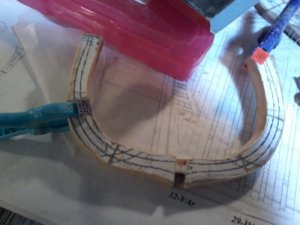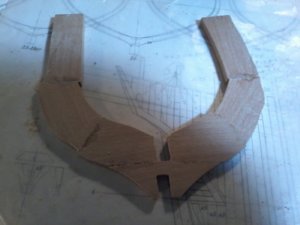Hi Lawrence,
Your post is very familiar and follows recent posts from others and unfortunately, it somewhat triggers a strong reaction in me. This comes up every once in a while and I have had this argument many times before, so my reply is not especially addressed to you… I just get a bit pissed in these cases.
Anyhow, I do not have the intension of picking a fight with anyone here (although I am certain Mrs Hanks will find an appropriate “smiley” for the content below), but I am sure he and a couple other members are expecting it, so I just need to respond one last time…
I still cannot understand why you are making your frames assembly so difficult.
What I personally still do not understand is the fact that some people are so obstinate into thinking that making frames any other way than what they know is more difficult. Honestly… is it?
Especially if one actually follows the guidance given including all the steps in sequence.
If you went back to your Halifax build, taped your plans to the back of a piece of glass, fit and glue up your framing pieces you will achieve a much easier and a much more enjoyable way in order to build your ship.
Refer to the reply above and add the following comment:
Making frames the way Don is trying to make them is not more difficult. The joint lines still have to be angled accurately for a good butt-fit to the part next to it, the notches still have to be cut, etc…. Yes you may assemble the whole frame template to make it one piece before the next step. Eventually, the frame pattern still needs to be transferred to the assembled blanks. Then, the contour of the frame still needs to be cut. Then the frame still needs to be beveled where needed. Then, Don still needs to make sure that all this is done fairly accurately, and for some reasons Don has listed, either way, he still needs to make his frames oversized to compensate for some probable errors.
So honestly, someone, please explain to me why is one technique more difficult than the other. The steps are the same and on top of everything else, please tell me what the difference is between Don’s last photo (above) and what some say is the easier way: the blank method.
It looks pretty much the same to me…
Furthermore,
Who the heck is to say that one way of making frames is more enjoyable one way or the other?
What does one really mean by that?
I am not criticizing you in any way, just trying to let you know there is a much easier and more enjoyable way to build all of those ship frames, [ my two cents worth] I am just trying to make things easier for you that's all.
There are 2 ways to avoid the “pain” of building frames.
1) have them laser cut or move on to build a kit. Curtom lasercutting will not avoid assembly and everything needing to be done after that.
2) I you want to still scratch build your ship, accept the fact that building frames is boring, repetitive, monotonous, a pain in ass and that you need to pay attention to what you do while following certain steps.
It does not matter what technique you use. Using that other technique, cutting dozens of blanks to correct angles is just as painful. Assembling the blanks is just as painful. Cutting the entire frame pattern in 1 piece is just as painful. Cutting the frame to final shape is just as painful. Beveling the sides of frame that need it is just as painful.
Again,
I am not entirely sure why some people think their way is easier, more enjoyable and whatever other adjective one may add, than the other. To me it is just different, as it requires the same basic steps, the same attention to details and it will give the same results, the same “enjoyment”. If I may make a suggestion… try the other way sometimes.
There seems to be a “cultural” divide on this subject and that is unfortunate.
In any case, “blanks” or not, Don’s frames are pretty much done. The 2 layers only need to be assembled. Form there ….. we will see.
Furthermore, one would find that making frames while following given guidance is actually quite enjoyable. Again as long as it is done following steps in proper sequence: and I would add, the same would apply to the other method.
It would be easy to mess-up using either method.
Just my 2 cents.









